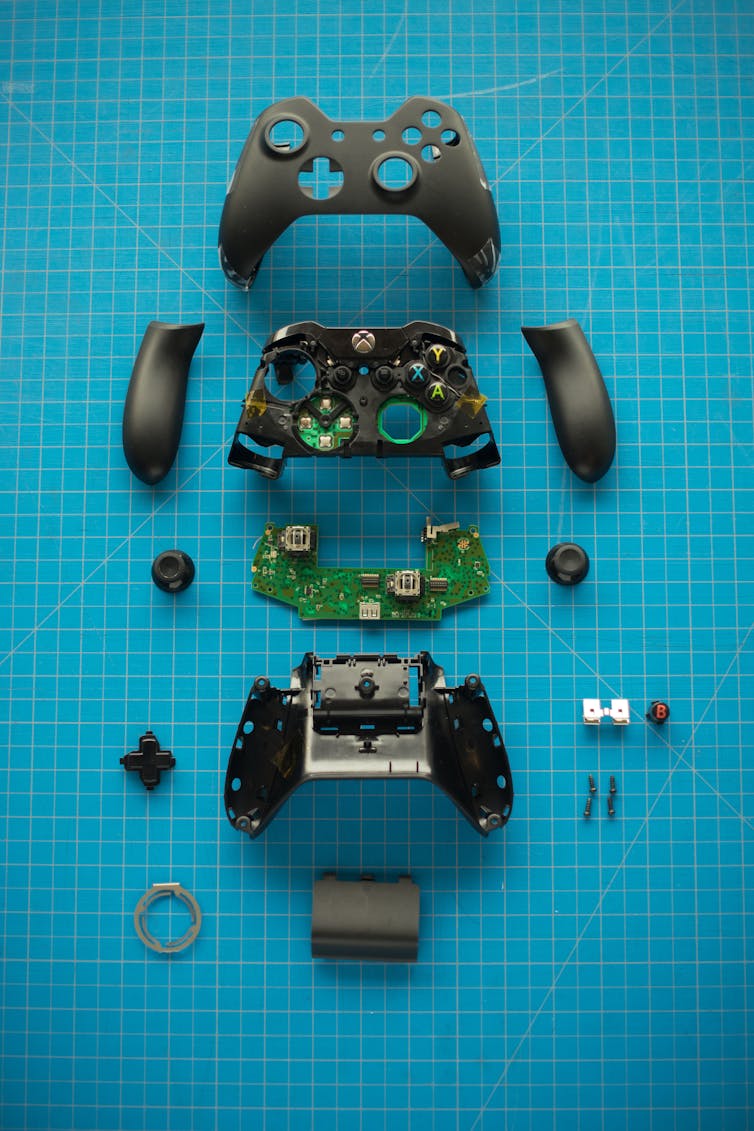How do remote controls work?
- Written by Andrew Maxwell, Senior Lecturer, University of Southern Queensland
This is an article from Curious Kids, a series for children. The Conversation is asking kids to send in questions they’d like an expert to answer. All questions are welcome – serious, weird or wacky! You might also like the podcast Imagine This, a co-production between ABC KIDS listen and The Conversation, based on Curious Kids.
How do remote controls work? – Ethan, 10, Sydney.
Thanks, Ethan. I was younger, I wondered the same. I was completely mesmerised with how a lump of plastic could possibly change channels on a TV without any physical connection.
Very early TV remote controls worked with wires. Then we created battery-powered remotes and we didn’t need the wires any more.
Now remotes are everywhere. In fact, the planet-watching Voyager spacecraft are controlled remotely and they are presently 20 billion kilometres away. It takes 20 hours for instructions to travel from Earth to the spacecraft but we can do it – using a remote.
Read more: Curious Kids: How do x-rays see inside you?
 A controller from a console game is a type of remote.
seanwhelan/Unsplash, CC BY
A controller from a console game is a type of remote.
seanwhelan/Unsplash, CC BY
A remote control has three things, what engineers would call a “communications channel”, a “procotol”, and an “interface”. I will explain what those words mean.
The communications channel
The communications channel is what connects the remote to the device you want to control (like a TV).
It could be light (such as infra-red light), sound or radio waves (sometimes called electromagnetic waves). The human eye cannot see infra-red light or radio waves.
TVs tend to use infrared light as it is low cost, easy to build, and suitable for a short distance like in a lounge room. However, it does require a direct “line of sight” so that the light beam is not blocked. How many times have you heard “get out of the way!” when someone is trying to change the channel?
Radio waves are usually used for long distance situations, or for outdoors, and can even travel through objects.
Many game consoles like the XBox and PlayStation use low power radio waves (like Bluetooth, which is a type of radio wave system). This is great for games as it does not need line of sight. It will still work even if you bounce around the room, or dive behind the couch with your controller.
Protocol
You can think of the protocol as the “language” the remote uses to communicate with the TV, XBox or whatever the device may be.
TVs, for instance, use a long list of “binary codes” (on and off, or one and zero bit sequences) that tell the TV what to do. Some codes tell the TV volume to go up, others tell it to go down, or change channel.
These patterns have been predetermined so that the TV will understand the remote. It can “speak” the language of the remote. The remote will package the message up in a little packet of data that the TV can understand.
Some remotes are able to send messages and receive them. For instance, a game console control will send commands to the console (eg “move the character forward”) and can receive them (for example, “make the controller rumble and vibrate”).
User interface
“User interface” is just a fancy way of saying how the remote looks and is used.
TV remotes just have a rather boring array of buttons. Some remotes have a screen and look like a mobile phone.
Pump up the volume
Say you want to turn up the volume on your TV. You press a button on the remote. The little microcontroller (which is just a tiny computer) in the remote wakes up, and reads which button you have pressed (“volume turned up, please”). It then creates a packet of data – a message – in a language the TV can understand.
It sends the message via an infrared light to the TV, assuming you aimed the remote correctly.
That message is then picked up by the infrared TV receiver, which decodes it (“ahh, he wants the volume turned up, ok.”). Then the small microcontroller (a tiny computer) in the TV makes the necessary changes to the volume.
All remotes all are designed to:
- take your request
- apply the protocol (translate it into a language the device can understand)
- create a packet of data (a message) and
- send the message via the communications channel to the device.
You then put these things together and you have a remote control.
Even the remote used to control the Voyager Spacecraft follows the same method. It’s no more complicated than controlling a TV, it just has more steps to it.
Thank you for this question, and I hope I have helped you understand the fascinating world of remote controls.
Read more: Curious Kids: How and why do magnets stick together?
Hello, curious kids! Have you got a question you’d like an expert to answer? Ask an adult to send your question to us. They can:
* Email your question to curiouskids@theconversation.edu.au * Tell us on Twitter
 CC BY-ND
Please tell us your name, age and which city you live in. You can send an audio recording of your question too, if you want. Send as many questions as you like! We won’t be able to answer every question but we will do our best.
CC BY-ND
Please tell us your name, age and which city you live in. You can send an audio recording of your question too, if you want. Send as many questions as you like! We won’t be able to answer every question but we will do our best.
Authors: Andrew Maxwell, Senior Lecturer, University of Southern Queensland
Read more http://theconversation.com/curious-kids-how-do-remote-controls-work-103840





